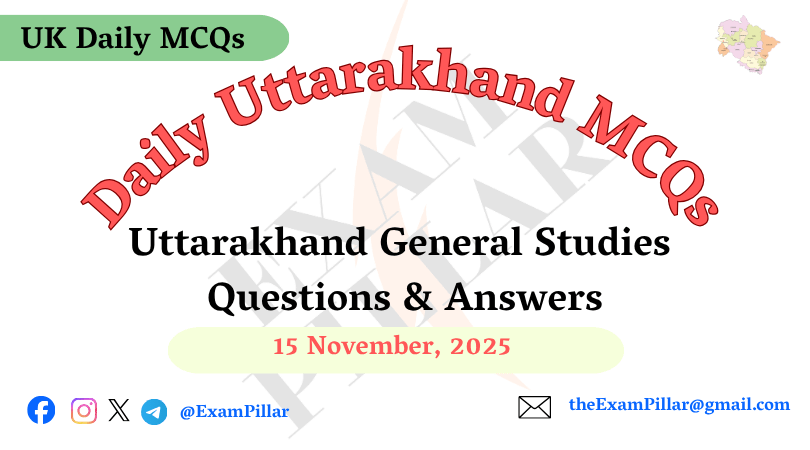The Exam Pillar brings you the Daily MCQs program for examinations conducted by the Uttarakhand Public Service Commission (UKPSC) and the Uttarakhand Subordinate Services Selection Commission (UKSSSC). This program provides candidates with objective study materials tailored to the exam format of the Uttarakhand Public Service Commission and the Uttarakhand Subordinate Services Selection Commission.
Daily UKPSC / UKSSSC MCQs : Uttarakhand
15 November, 2025
| Read This UKPSC / UKSSSC Daily MCQ – (Uttarakhand) in Hindi (हिन्दी) Language |
Q1. How many human figures were discovered from Lakhu Udyar by Yashwant Singh Kathoch in 1982?
(A) 5
(B) 6
(C) 7
(D) 8
Click To Show Answer/Hide
Explanation: In 1982, Yashwant Singh Kathoch discovered 7 human figures from Lakhu Udyar. These figures are significant because they clearly represent the artistic expression, collective life, and cultural activities of prehistoric humans.
Q2. How many total colored paintings were found in the Gwarakhya Cave, and how many of them depicted animals?
(A) 35 paintings, 5 animal figures
(B) 41 paintings, 8 animal figures
(C) 50 paintings, 10 animal figures
(D) 30 paintings, 6 animal figures
Click To Show Answer/Hide
Explanation: A total of 41 colored paintings were discovered in the Gwarakhya Cave, out of which 8 depicted animals, and the remaining were human figures. This indicates that ancient people were interested in portraying both human and animal life, and the subjects of the paintings were related to their social and economic activities.
Q3. What is the main theme of the rock paintings of the Gwarakhya Cave?
(A) Group dance and festivals
(B) War and hunting
(C) Driving or trapping animals, and human figures drawn in trident-shaped patterns
(D) Agriculture and water sources
Click To Show Answer/Hide
Explanation: The main theme of the rock paintings in Gwarakhya Cave is driving or surrounding animals, and drawing human figures in trident-like shapes. This suggests that people of that time artistically represented pastoral and hunting activities, providing insight into their economic and social life.
Q4. In which year and by whom was Kimni village discovered?
(A) In 1995 CE by Yashwant Singh Kathoch
(B) In 1998 CE by M. P. Joshi
(C) In 2000 CE by Yashodhar Mathpal
(D) In 1992 CE by Rakesh Bhatt
Click To Show Answer/Hide
Explanation: Kimni village was discovered in 1998 by Dr. M. P. Joshi. This discovery, located in the Pindar River valley of Chamoli district, proved important for the study of prehistoric rock art. It provided evidence of early human presence and cultural activity in the region.
Q5. Kimni village is located near which place?
(A) Alaknanda Valley, Hugri village
(B) Pindar River Valley, Tharali, Chamoli
(C) Yamuna Valley, Hudli, Uttarkashi
(D) Ramganga Valley, Maharu Udyar
Click To Show Answer/Hide
Explanation: Kimni village is located in the Pindar River Valley, near Tharali in the Chamoli district. Its geographical location is ideal for preserving prehistoric human activities and rock paintings.








